#a fun thing i like to do is go through an actors filmography on letterboxd and look at films of theirs you havent seen
Explore tagged Tumblr posts
Text
kate bush if she used letterboxd: ill put it on the watchlist
#is this anything. sorry im browsing letterboxd and the wedding list is stuck in my head#a fun thing i like to do is go through an actors filmography on letterboxd and look at films of theirs you havent seen#and unfortunately sometimes you may find that nope youve already seen all the good ones. only the bad ones are left#and other times you find something to kate bush voice PUT ON THE WATCH . LIST!!!!!#sorry. anyway right now im going through james spaders filmography for personal understandable reasons#insane to me hes only done 49 movies feel like it should be more??? oh well#when i get to hell i will be looking for the people that made the dvds of curtain call without any subtitles or closed captions#i cant process audio bitch . let me understand what that goofy boy is saying. apparently on streaming its got subtitles let me have themmmm#anyway. in this coming winter when i need to cling to things to enjoy i may be watching more movies
11 notes
·
View notes
Text
Hit Man (2024) review
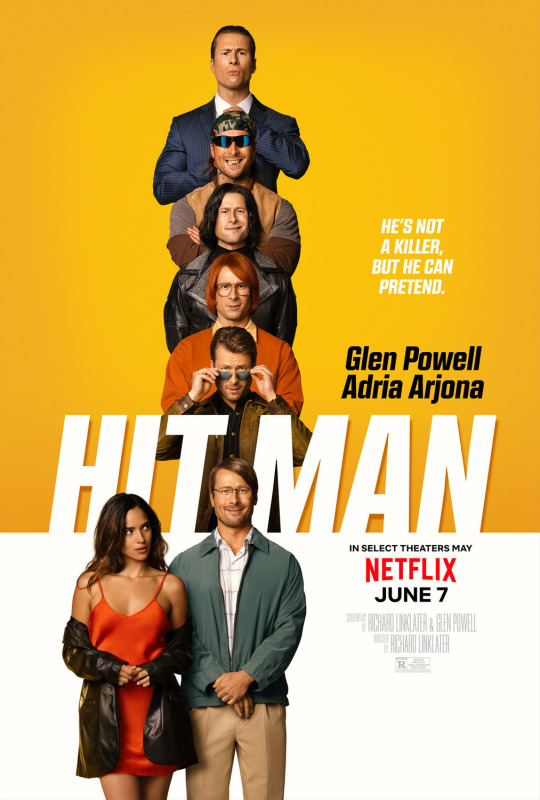
Is it too late to start a campaign for Glen Powell to be cast in Knives Out 3? Think he’d fit right into Rian Johnson’s world of suspects. Also I’d just love to see Powell riff off Daniel Craig’s Benoit Blanc. Then again I’d watch anyone riff off Benoit Blanc. Gosh I love those Knives Out films - can’t wait for the next one.
Plot: Gary Johnson is the most sought-after professional killer in New Orleans. To his clients, he is like something out of a movie: the mysterious gun for hire. But if you pay him to rub out a cheating spouse or an abusive boss, you'd better watch out, he works for the cops. When he breaks protocol to help a desperate woman trying to flee an abusive husband, he finds himself becoming one of his false personas, falling for the woman and flirting with becoming a criminal.
The ever so reliable Richard Linklater has up-kept such a varied filmography, but one of which all the films have a certain vibe to them. They are all “chill” movies. Even his more daring out-there projects like the sci-fi thriller adaptation of Philip K. Dick’s novel A Scanner Darkly in the hands of another director would have been this sprawling cyberpunk noir epic on the scale of Blade Runner, however Linklater’s take holds this passive coolness about it, that only a Linklater such as himself can do. With his new film Hit Man, he’s following up his interest in picking out random crazy true stories from newspaper articles (as he previously did with Bernie, the 2011 Jack Black dark comedy that is a fine watch, but features arguably the worst movie poster in film history), and this movie has had one hell of a ride through the film festival circuit last year. Rave review after rave review painting this to be the best rom-com of the last century. Of course the last thing I’d expect is for something to be overrated, cause I mean that never happens, so naturally I prepared for the second coming of Christ as this film released on Netflix this week.
Hit Man is a perfectly fun Richard Linklater film, with a simple yet quirky story that is filled with enough twists and turns on the way, fantastic chemistry from its two main stars and yet again that signature chill hang-out feel the director is known for. Naturally going to give this movie credit where credit is due, it has already begun an online trend amongst folks on Letterboxd leaving one-liner reviews saying “it’s a hit, man!”, so now just wondering how long it will take for that joke to get old. Clue: it already was. However as for it being the best romantic comedy ever, it is far from it. Again, it’s a good time, but the movie relies most sorely on its superstar central performance.
Glen Powell truly exemplifies as Gary Johnson. To be fair, this role is a dream for any actor, allowing them to stretch their skills to take on multiple different personas, such like James McAvoy in Split or on a smaller scale Tom Hardy in Legend. And so a major entertainment factor throughout the first half of the movie was seeing Powell take on the different eccentric disguises, whether it be a stone cold generic hit man with a focus on attitude and professionalism (I’m assuming this was inspired somewhat by Alain Delon’s steely-eyed loner in 1967’s Le Samouraï); to a soft spoken Englishman dressed in 70s yellow, holding them oh-so eloquently as if he’s just walked off the set of a Wes Anderson production; to wading through the New Orleans heat while wrapped in black leather, the stub of a cigar poking through his stringy black hair, adopting a strong Eastern European accent to growl out his responses, very reminiscent of the stoic Russian stereotype from action flicks. It’s all fun and games and Glen Powell truly steps up to the task. To be fair to him the guy has been solid since I’ve first seen him back in Linklater’s other movie Everybody Wants Some!!, and since then it’s hard to overlook the guy’s natural charm and charisma. Even if he does look a little like a capybara - once again thank you to the lovely world of the internet for enlightening me with that comparison that now I can’t take out of my head. As for Powell’s counterpart, Adria Arjona is perfectly fine as the love interest, however he chemistry with Powell is off the charts. The two seem so natural riffing off one another that I found them much more believable to whatever Powell and Sydney Sweeney were up to last year (off or on camera that is).
The film does suffer from some pacing issues, especially to the middle when it lingers a little too long on the rom-com cliches, so much so that it slows down the film to a halt and I’m like I get it, you love each other, you’ve consummated this point a gazillion times already, so get on with it! But then it does get going again, and I really enjoyed Austin Amelio (Dwight from The Walking Dead) playing, essentially, the dick of the rom-com genre. You know the guy who always gets in the way of the couple and tries to screw things over. It helps that Amelio has a really punchable face, so he fit the bill. I also appreciated the infusion of philosophical insights during Gary’s teaching classes that provided an unexpected layer of intellect, elevating the overall experience. And this movie features some truly laugh out loud moments. Like it’s been a while where I’ve seen a modern comedy that had me laugh out loud. Usually I just politely chuckle. So yep, it’s a solid good time, and the two leads are delightful to watch, but this isn’t Linklater’s best work. Again, don’t let that sway you away, this is an entertaining little film for what it is. All pie is good pie.
Overall score: 7/10
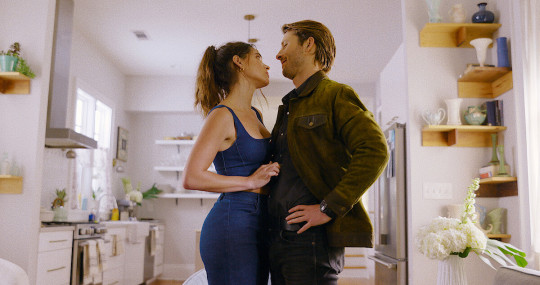
#hit man#glen powell#glen fucking powell#adria arjona#richard linklater#austin amelio#movie#movie reviews#film#film reviews#comedy#cinema#romance#rom com#hit man review#netflix#2024#2024 in film#2024 films#streaming#chemistry#retta#sanjay rao#hitman#crime#Skip Hollandsworth#hit man Netflix
13 notes
·
View notes
Photo
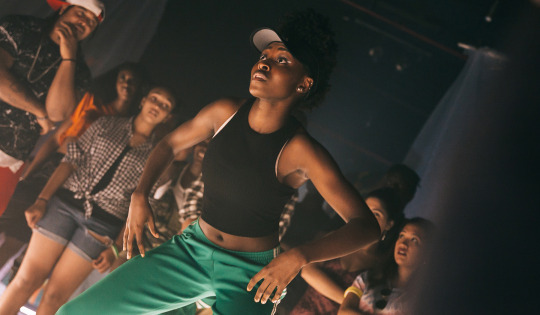
Third Language.
With her debut film Farewell Amor out now following a successful journey on the festival circuit, Tanzanian-American writer and director Ekwa Msangi tells Selome Hailu about the third language of music, growing up on knockoffs of the Rambo franchise, and her favorite African filmmakers.
There’s a subtle musicality central to the way Ekwa Msangi carries herself. She finds melodies in her words: “You hum the ‘m’,” she says when asked how to pronounce her last name. “Mmm-sangi.” And perhaps to a more subconscious degree, she speaks with rhythm, too: “I do think, and I know, and I can see…” she trails off, ruminating on how much hope she feels for the future of Black filmmaking. Naturally, this musical quality meanders into her work.
Farewell Amor is a quiet film, except for when it isn’t. Three Angolan immigrants revolve around each other in an awkward orbit, each trying to make sense of their dynamic now that they’ve left their home behind. Kept apart for seventeen years by the bureaucratic intricacies of war and paperwork, Walter (Ntare Guma Mbaho Mwine) is finally joined by his wife Esther (Zainab Jah) and daughter Sylvia (Jayme Lawson—soon to be seen as Bella Reál in The Batman) in New York City. But they don’t know each other anymore and spend much of their time in silence, until music and dance burst forward as a chance at common ground.
Msangi’s screenplay never dwells on the technicalities of the family’s struggle against the American immigration system. Instead, it plunges into softer, more personal after-effects of dreams deferred. Walter’s walls bear a faded calendar with Barack Obama’s face on it, even though his empty apartment complicates the “hope” the president promised people like him. When his family arrives at long last, Esther wears a silver cross pendant, having made sense of these years as a married-yet-single mother by drawing closer—almost too close—to religion. Sylvia barely speaks at all, caught between a faith that isn’t hers and a home that isn’t either.
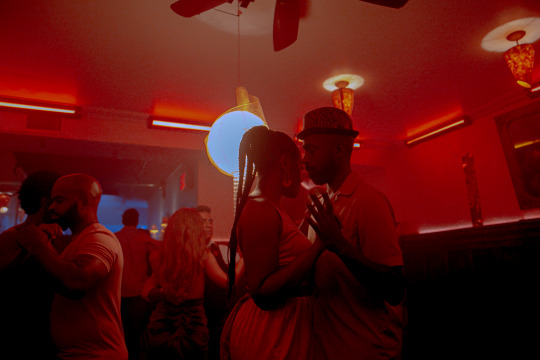
Ntare Guma Mbaho Mwine and Nana Mensah in ‘Farewell Amor’. / Photo courtesy IFC Films
The film’s triptych structure emerged after Msangi spent months grappling with how to create a feature-length screenplay out of her original short film. “Having just come off of the short, I was focusing on Walter’s story. But [I] didn’t think that was the most original story I could tell,” she says. “And then, out of indecision between whether I should make it Walter’s or Sylvia’s story, I decided to just do both. Initially it was two perspectives that I was looking at. But I realized that Esther’s story was really the linchpin for both of their stories, and it wouldn’t make sense not to have hers.”
Giving Walter, Esther and Sylvia their own chapters makes Farewell Amor a stronger film than if it had followed a singular, traditional protagonist. Extreme conservatism in one chapter is revealed as a desire to avoid pain in another; one character’s cramped living room is another’s space to dance freely. Writing on Letterboxd, Tabby points out how the three-part narrative structure grants meaningful subjectivity to characters who deserve it: “It’s so easy for Westernized perspectives to steamroll over films that deal in cultural disparities and thematics, but Farewell Amor takes important steps in showing all sides of the story,” she writes. “It was refreshing to see [the characters] each given the space to exist.”
This layering of voices happens in the camerawork, too. Each section of the narrative is marked with a visual language of its own, complete with specific color palettes and cinematographic techniques. Msangi thinks fondly about the work she put in with cinematographer Bruce Francis Cole to make the chapters distinct. “For Walter’s, it’s sort of a slow cinema, where there’s a lot of still framing. It’s almost like he’s stuck, you know? Stuck in the frame between two surfaces, two hard surfaces, a window frame, a door frame. And in Sylvia’s, we wanted to have it reflect her livelihood, her restlessness. All handheld cameras, all movement. And then for Esther, she’s very observant. She’s been taking everything in, almost in an investigative style, but also a little bit romantic. She’s romanticized this setup, so a lot of close shots, a lot of soft lighting.”
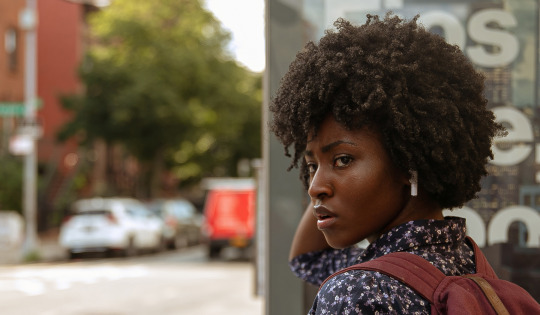
Jayme Lawson as Sylvia in ‘Farewell Amor’. / Photo courtesy IFC Films
Music gives Farewell Amor a cohesion across the different storylines. “Music is, for these characters in particular, and for me, kind of a third language,” Msangi says. “It gives you a glimpse under the covers, what’s under the sheets.” The soundtrack underscores strong performances from Mwine, Jah and Lawson, lending depth to their quietude and vibrance to their movement. Msangi also notes how sound became a cornerstone of her collaboration with the actors: “As I was writing from different perspectives, in order to help me get into each character’s skin, I would listen to the music that they would be interested in.” She later shared these playlists with the actors, using the songs to communicate what words couldn’t.
Msangi has a good laugh as she tries to think about the major films that inspired her to become a filmmaker. “You know, I don’t have that. Well, I do have that, but not for the reasons that most of my film peers have,” she says. Growing up in East Africa in the ’80s and ’90s, little to none of the programming on television was local. What did kids watch instead? “We watched Rambo for probably ten years straight, and then Rambo knockoffs for another ten years after that. I decided to become a filmmaker because of horrible Rambo knockoff films.”
“I grew up surrounded by such colorful and delightful and interesting and funny people,” Msangi says. “And none of that was reflected anywhere in the media.” As she grew older, she sought out African films she couldn’t access in her youth. Now, they’re some of her highest recommendations. Ousmane Sembène is the first African director whose filmography she ever got the chance to dive into. Sembène’s 50-year career has garnered him the affectionate title of ‘Father of African film’ among many critics and scholars, who laud him for his dramas, including Black Girl and Camp de Thiaroye. Msangi, however, finds herself taken with his unique sense of humor. She has also been inspired by Safi Faye, another Senegalese director, who became the first sub-Saharan African woman to attain commercial distribution in 1975—and whose film Mossane portrays sexual intimacy with an openness Msangi hadn’t seen elsewhere.

Writer-director Ekwa Msangi. / Photo courtesy IFC Films
In Farewell Amor, Sylvia’s chapter reads like a compacted coming-of-age film. Msangi points to South African director Darrell James Roodt’s Sarafina! as an influence in that regard. “It was showing for two weeks in Nairobi, and I lined up for four hours to watch,” she says about the film, a drama about youth involvement in the 1976 Soweto uprising. “Even though it’s from a different part of the continent, I’d never seen young African teenagers on a screen before.” More recently, she has loved 2011 TIFF breakout and Oscar contender Death for Sale by Moroccan director Faouzi Bensaïdi, and Radha Blank’s The Forty-Year-Old Version is her favorite film of 2020. She’s hopeful about the future of Black American cinema: Ava DuVernay and Ryan Coogler are two of her favorite working directors.
Msangi’s selections are wide in range, but there’s still one thing holding them together: themes of vulnerability, community and celebration of identity, across different decades and genres. In fact, her approach to watching movies isn’t far off from the way she made her own—Farewell Amor maps concurrent experiences of disparate people, and Msangi’s tastes seem driven by the same balance of vastness and specificity.
“I’m a filmmaker who really abhors working on the same kind of story over and over again, the same genre, the same kinds of characters,” she says. “So I’m not going to make my career just telling stories about immigrants or about, you know, their wretched troubles,” she laughs. “I don’t want to do that.”
Msangi’s next project will be an African-American period piece; beyond that, she hopes to make films in several locations: the Caribbean, Europe and all over the African continent. “I really would like to just have a lot of fun with my career. You know? Because it’s a fun and magical industry that we work in! The work that we do in creating these stories and hopes and dreams—we create magic, so it should be fun.”
Related content
Adam Davie’s Black Life on Film list
Shachar’s 20 Films by Black Directors 2021 Challenge
Screenpaige’s list of Black Women in Film
Follow Selome on Letterboxd
‘Farewell Amor’ is out now in select theaters and on demand through IFC.
#ekwa msangi#jayme lawson#farewell amor#african cinema#black filmmaker#black director#directed by women#52 films by women#female director#black woman director#american film#drama#romance#dance film#angolan cinema#angola#letterboxd
33 notes
·
View notes
Text
September 2018 in Review
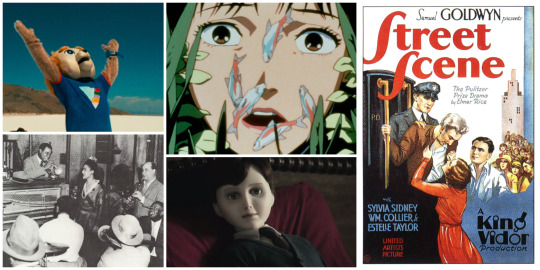
You should all be proud of me this month, as I actually watched MORE than one movie made in this decade. There was little rhyme or reason to the films I watched this month. I was pretty scattered honestly and my viewing habits show it. I keep a full diary on letterboxd and IMDB.
A major highlight of September was TCM’s month-long series hosted by the African American Film Critics Association (AAFCA) The Black Experience on Film. I only caught a few of the films but went out of my way to watch the introductory conversations. TCM’s Trailblazing Women series with Illeana Douglas was a favorite feature of mine and I’d love to see even more hosted series for marginalized groups in film history. It might be too much to suggest Disability on Film… But I’ve been considering doing a blogging series on that myself!
The reviews below the jump are essentially transcriptions of the notes I took right after watching the films. They’re presented in the order in which I watched them.
Brigsby Bear (2017)
23 January 2017 | 97 min. | Color

When Brigsby Bear came out there were a number of people, in real life and online, who gushed about it non-stop. I was pretty wary to see it. In the past, often when people around my age pick out a new darling film or TV series, I’ve been burned. Sometimes it’s something cynically violent in a way that’s disturbing to overlook. Sometimes it’s something with too much ironic detachment for my taste. Or it’s something straight-up ableist, sexist, or bigoted. (How are we still traumatizing all “Strong Female Characters” in the 2010s. Come on.)
BUT, Brigsby Bear was really good!? I honestly wasn’t expecting such a heartfelt and humanist film. A modern comedy movie that has faith in the good of all people? Amazing. I hope that the success of this film can be the beginning of a new chapter of millennial comedy so we can wholly move on from calling cynical intellectualized bigotry humor.
I got emotional as the friendship between Spencer and James developed. Maybe because I’m a clinically strange person myself. I don’t always have the energy in social situations to keep my neurotypical mask on and when I show my actually autistic self to people it doesn’t usually go all that well. That’s why it’s a special, joyful moment to find acceptance. Brigsby captures this so well. That feeling where people suddenly like you for your weirdness, rather than getting aggressive over it, is like a psychological hug. Kyle Mooney’s portrayal of James in those moments of acceptance is very true to life.
It’s refreshing to have the tension of a comedy film built around a feeling that misunderstandings might make everything fall to pieces. And then the tension releases because everyone is trying so hard to be their best self and things get sorted. I’m used to this dynamic in quite a few old romantic comedy films, but it’s a strategy not employed all that often today. If this is where millennial art is headed I’m ready to take out the trash marketed to us in the last decade.
At first I was worried that this was going to be another early 1980s throwback nostalgia piece without the spirit of media it was referencing (yes, I’m already fatigued by this). That thought was dispelled quickly.
The casting is great. The use of Mark Hamill is particularly ingenious.
Where to watch: it’s currently on demand through Starz.
Perfect Blue (1997)
28 February 1998 | 81min. | Color

Perfect Blue is a must-see for giallo fans, I think. It was very cool to see a Japanese filmmaker create a giallo-inspired psycho-detective thriller and specifically to see Satoshi Kon’s take given his skill in weaving tales about identity.
Perfect Blue is a harsh criticism of Idol culture (and, more broadly, fan culture).
This film requires a huge content warning for sexual violence and assault. If I hadn’t been watching Perfect Blue in a theater, I absolutely would have had to pause the film and take breaks a few times. Which is why, if you haven’t seen any other Kon films, it might be best to start elsewhere–even though Perfect Blue was his first feature. My first exposure to Kon was a few years back with Millennium Actress (2001) and then Paprika (2006). Both are great for newcomers to Kon. Paprika is usually the easy to find. Tokyo Godfathers (2003) is also worth watching, but pretty far afield from Perfect Blue.
Now I’m not suggesting that Perfect Blue isn’t good. It’s great. It’s simply that it’s such an intense and potentially triggering film that it might put some people off Kon’s other work. That may well have happened to me if this had been the first Kon film I saw rather than my last of his filmography.
As with Kon’s other films, the animation is fantastic and imaginative. I don’t want to give too much away about the story, so feel free to ask if you need more specific content warnings.
Where to watch: This one’s not so easy to get your hands on. Your local library or video store might be the best place to look. But, GKids does have some theatrical screenings upcoming.
New Orleans (1947)
18 April 1947 | 90min. | B&W
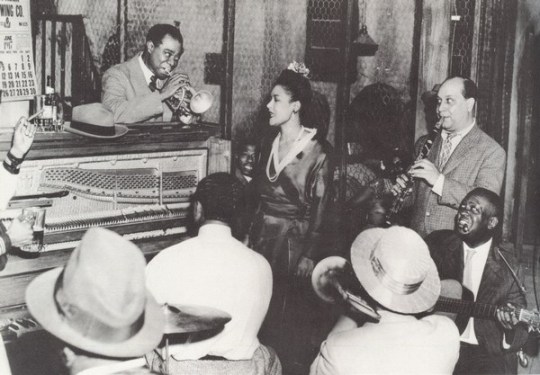
I watched this film on TCM as part of the aforementioned Black Experience on Film series with AAFCA.
As it was a month-long series in September, I probably should have mentioned it sooner, but the whole series was fantastic. The critics offered useful context for all of the films. Given that the films elicit mixed responses and have complicated roles in cultural and social history, it was very cool to see people debate and disagree on the films. It was valuable to witness even the disagreements that weren’t all that complicated and more about personal taste than politics. With New Orleans for example, one of the hosts liked the film and the other disliked it, though both held an appreciation for it. More civil disagreement about films, please and thanks.
I liked New Orleans and am disappointed that I hadn’t even heard about it before. Although, I do agree with critic/host Jamaal Finkley that it’s a disappointment that New Orleans doesn’t provide any insight into the personal trials of the Black characters.
It’s always a treat to see Arturo de Cordova, but that goes double when it’s an American film where his role isn’t informed by Latin/Mexican stereotypes. This is actually one the more refreshing aspects of the film. The Black characters lack interiority and their struggles are left out of the film, but Louis Armstrong’s and Billie Holiday’s characters are average people and don’t hew to stereotypes. It’s not exactly a victory for representation, but it’s still an improvement.
That said, the music is great and I wish there were more of it. It’s well established in the film that New Orleans’ problems largely come from badly-behaved white people, which I appreciate. (Is that too real?) Arturo de Cordova is great as the romantic lead of the film. I only wish Dorothy Patrick had the charisma to seem like a better match for him.
New Orleans is definitely worth checking out if the progress of Black representation in film is of interest to you or if you have a special interest in jazz or New Orleans.
Where to watch: It looks like Kino’s DVD release might be out of print, so libraries & video stores might be your best bet. OR, you can wait until TCM plays it again.
The Boy (2016)
22 January 2016 | 97min. | Color

Sooooo depending on how long you’ve been following the blog, you may or may not know that I love horror movies and ghost stories and whenever those things meet. When I first saw the trailers for The Boy ahead of its theatrical release, it did pique my interest. However, that’s mostly because they made me laugh. I am not someone who’s creeped out by dolls though. If you are, I suspect this film actually might be scary to you.
The Boy has a solid premise. At first it reminded me of the story “Baby Doll” by Larry LeClair from the radio show Nightfall. (”Baby Doll” is a better story, FYI, and creepier.) Unfortunately, the execution of The Boy’s story was disappointing. The film drags when it shouldn’t and the flow of the lead character warming to the doll felt stilted. The Boy’s big reveal ended up feeling a bit cheap as a consequence.
That said, I had fun watching it. I got some good laughs from Brahms’ ghostly antics and the middle part of the film is chock full of them.
The house from the film is so beautiful. I can’t believe it’s in Vancouver. Or that it’s a location for Little Women (1994)? I somehow didn’t recognize it.
Whether The Boy is worth a watch is debatable. If you like Haunted Doll stories, the execution and ending might be unsatisfying for you. Maybe if you like the odd modern horror film that can’t embrace its own camp, The Boy would be perfect for you?
Where to watch: It’s currently streaming on Netflix.
Street Scene (1931)
5 September 1931 | 80min. | B&W

This movie was a good old kick in the pants.
Street Scene an adaptation of a Pulitzer-Prize-winning stage play by Elmer Rice. It depicts the problems of New York City tenement residents and their relationships with one another. Though this is a pre-code film, I still imagine there would have been notable changes for censors. That said, the film is still very… mature. Additionally, I’ve seen suggestions that the film we know today is a re-edit of the film for post-code re-release. Hoo boy, what that source material must have been then.
One challenge a lot of filmmakers have when adapting stage plays to film is avoiding static staging–as if someone simply recorded the play. Street Scene doesn’t fear this and I think it works out. Almost all of the film takes place on the stoop of the tenement. The building facade is a truly impressive setup for filming. The camera work livens up the visuals with tracking shots and unexpected angles not commonly seen in early-sound films. (Unsurprisingly, Gregg Toland worked on the film!)
The acting is fantastic and, as someone who has spent the lion’s share of her life in cultural melting pots, the atmosphere the actors create is very authentic. Frankly, after living in Brooklyn for five years (four years ago), some neighborhoods still feel like this–only the voices are Puerto Rican and West Indian instead of European. It’s fascinating to see those veins of permanence in a city that’s changed as much as New York has.
The story primarily focuses on one family. The matriarch (Estelle Taylor) is bored with her unhappy marriage and takes up with the man who collects payment for milk delivery. The eldest child, Rose (Silvia Sydney), is pursued by seemingly every young, eligible man on the block and her not-so-young and not-so-eligible boss. The only one Rose shares feelings for is her downstairs neighbor, an unemployed student, Sam (William Collier, Jr.), who also happens to be Jewish. There is plenty of external resistance to their relationship for anti-semitic and/or financial reasons. Rose’s misgivings are a little more complicated. She feels trapped by the neighborhood and is wary to tie herself down to her current status at so young an age, regardless of how she feels about Sam. In the end, Rose’s mother’s fate cements her own. You can’t help but feel for both of them.
In case you haven’t already gathered this, the film calls for a content warning for anti-semitism and the use of anti-semitic slurs. [Note for clarification: the film is not anti-semitic, a few of the characters are.]
Street Scene takes social issues head on and is a pre-code through and through. It’s absolutely a top recommendation if you like pre-codes. It’s also worth watching if you’re into New York City history or have an interest in film adaptations of stage plays.
Where to watch: This one is pretty easy to see, but I haven’t sussed out the distribution rights or home video releases.
I also watched the film Sanatorium pod Klepsydrą / The Hourglass Sanatorium (1973). That left me with too many feelings to put in an amalgam post. Once I sort through how personal I want to get in discussing the film publicly, you can be sure it’ll get its own post up here.
Last Month’s Review
#Film Review#film blog#month in review#monthly roundup#brigsby bear#2010s#2017#comedy#perfect blue#satoshi kon#animation#animated movies#anime#giallo#horror#Horror Movies#horror film#suspense#1990s#1997#1998#new orleans#1940s#1947#Louis Armstrong#billie holiday#Arturo De Cordova#romance#2016#ghosts
10 notes
·
View notes
Photo
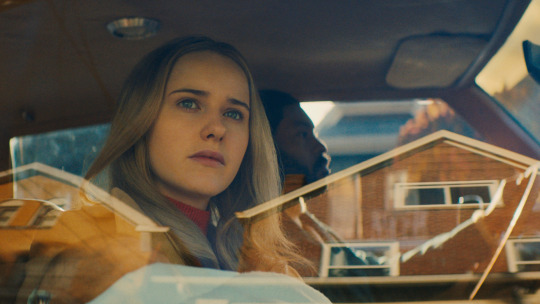
Natural Woman.
Filmmaking power-couple Julia Hart and Jordan Horowitz chat to Jack Moulton about exploring untouched female perspectives in genre films, a fateful viewing of Michael Mann’s Thief, the humbling magic of babies on set, and Letterboxd’s small role in their filmmaking process.
I’m Your Woman puts the gangster’s moll, a classically underwritten character, at the heart of the action. We barely meet the gangster himself in this taut, 1970s-set crime thriller from director Julia Hart and her co-writer and producer husband Jordan Horowitz. Rachel Brosnahan occupies a tense and unusual space as Jean, wife of Eddie, a no-good chap who turns up one day with a very young baby then abruptly disappears, leaving her to raise this unnamed child.
In other versions of the story, we’d follow Eddie to a guns-blazing conclusion, but this is a Hart-Horowitz jam, so we’re quickly on the run with Jean and the baby, and we stay with her. I’m Your Woman is a compelling, unsettling twist on the genre. “What impressed me most … was how well it keeps its cards close to the vest,” writes Mikey on Letterboxd. It’s also an empathetic portrayal of new-motherhood in all its exhausting confusion, where getting a baby clean, fed and sleeping is as much a priority as finding the next safe house. “Despite valuing tension quite highly, Julia Hart still has the wherewithal to let it sit in its more tender and thoughtful moments,” writes Paul. “The ending really sneaks up on you in terms of the specific feeling it elicits.”

Marsha Stephanie Blake and Rachel Brosnahan in ‘I’m Your Woman’.
Hart and Horowitz have children, aged two and six, who have grown up around film sets. Before becoming a filmmaker, Hart spent her days with other people’s kids as a teacher; her 2016 debut, Miss Stevens, stars Lily Rabe as a high-school educator, but her follow-up films have been wider-ranging, from Fast Color to this year’s Stargirl. Hart credits this genre-jumping to her absolute love of movies. “I don’t have a favorite genre. I love musicals, Westerns, crime dramas, coming-of-age movies, superhero movies. It was so fun getting to learn about how to create musical numbers in Stargirl and how to direct a car chase in I’m Your Woman.”
Horowitz, meanwhile, is known for producing The Kids Are All Right and La La Land. Yes, he’s the “Guys, guys, I’m sorry, no, there’s a mistake” guy. Horowitz is also a Letterboxd member, and a hunt back through his diary reveals the date he first watched Moonlight, along with his wholesome reviews of Julia’s films. “I always tried to remember to log my movies in so many different ways,” Horowitz explains, “and then once Letterboxd came out it was a very easy solution.”
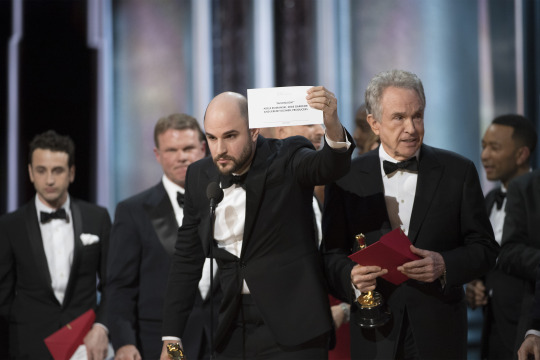
Jordan Horowitz corrects that famous Oscar mix-up.
Horowitz keeps diligent lists of references for his upcoming films, years before they’re even announced. It’s here that the roots of I’m Your Woman are found, if you’re looking closely: a fateful viewing of Michael Mann’s Thief nearly seven years ago was the primary influence on I’m Your Woman, “especially Tuesday Weld’s character, and the moment where she is basically asked to leave the movie before James Caan burns everything to the ground,” he tells me. “Our hope with this movie was to follow some of the women in those movies that don’t necessarily get the spotlight and shift the gaze of the camera to follow this car as it drives away with her in it, instead of staying with the criminal of this movie.”
Hart picks up the thread, naming Diane Keaton in The Godfather, Ali MacGraw in The Getaway, Theresa Russell in Straight Time. “Those were interesting characters played by incredible actresses but they only have a handful of scenes so I loved the idea of exploring a woman in that world and time but telling the story through her perspective.”
Horowitz defines master filmmakers Sidney Lumet, Martin Ritt and Jonathan Demme as Hart’s “spirit animals”, for their humanist takes in multiple genres. A particular recommendation of a Lumet classic from an Amazon executive changed the way they looked at their writing. “Running on Empty has this great scene where they all sing [James Taylor’s] ‘Fire and Rain’ together. Originally in our script, the ‘Natural Woman’ scene was just [Jean] singing. After watching that movie it inspired us to consider what if the Cal character joins in with her? What happens to the moment if it becomes a bit more of a community moment?”

Bill Heck in ‘I’m Your Woman’.
When talking about their writing process, Horowitz admits that he always has his producer hat handy: “I’m never thinking about writing for the sake of writing. I’m always keeping how we make this thing in mind. Do we have too many extras? Is this location gettable? That can help me when we get into production because I’ve already considered some of those things, but I do wish sometimes that I could just sit down as Julia does and just write.” Once the duo makes it into production, Horowitz admits “[I] definitely put writer mode behind me, to the point where we’ll be on set and someone will ask me something about the script and I’ll be like ‘I don’t know, ask Julia’ and they’ll say ‘didn’t you write it too?!’”
However, Horowitz credits Hart as the “idea generator” of the two. The premise to have Jean struggling to connect with her adoptive baby was always part of the conception of the character, largely based on conversations Hart had with mothers, pre-lockdown. “It sometimes feels like Hollywood sees mothers as a monolith where there isn’t much nuance and subtlety, especially when it comes to negative feelings about motherhood, so they’re often shamed into not talking about them,” Julia laments. “It was really important for me to explore a side of motherhood that isn’t talked about as much and make sure that mothers know that they are seen and heard.”
The decision to have a baby (performed by brothers Justin and Jameson Charles) in almost every scene was a big risk, and not one Hart took lightly. “Movie people can think what they’re doing is very important, but there’s nothing more humbling than when you’re on a whole set with hundreds of people [and] you’re waiting for a baby’s dirty diaper to be changed. It made everything feel so real and immediate, so everyone on set really had to live in the moment and adapt. You prepare, and prepare, and prepare, but you have to throw out so much if the baby is sleeping instead of crying, or crying instead of smiling. I think it’s important to portray babies as real people, because as a society we often forget that.”
Lead actress Rachel Brosnahan came on as a producer many years after the script was already in Hart and Horowitz’s heads, but Hart explains that Brosnahan brought a history and interior life, “more in the wordless moments of acting than in dialogue itself.” Along the way, Jean meets Cal and Teri, who guide her to refuge. They’re the heart of the film, and Hart elaborates on their importance to the narrative: “they have been through the hell that Jean is currently going through and her circumstances force them to go through it again, but this time they have honesty, truth and love on their side. In watching Teri and Cal, Jean starts to understand what real love, family and support are.”
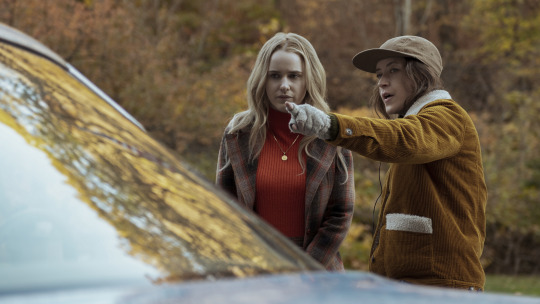
Rachel Brosnahan with director and co-writer Julia Hart.
When you examine Hart’s filmography, it’s impressive how productive she’s been in such a short time, releasing four films within five years, with those pre-schoolers under foot. Horowitz makes a comparison to a prolific filmmaker like Steven Soderbergh, who advises to “fail as fast as you can”. Horowitz acknowledges that “I don’t think we set out like, ‘we’re gonna have two children and we’re gonna make four films in five years.’ If we knew that we were gonna do that we would’ve said, ‘wow, that’s a little bit insane, maybe we shouldn’t do that!’” But they did, and the film world is richer for it.
We always like to ask about the film that made filmmakers want to become filmmakers, and Hart lands on All That Jazz. “I’ve always been a fan of Bob Fosse since his [early] work. How he turned moving your body in a way that people haven’t really moved their bodies before into an empire is very inspiring. [Roy Scheider] is also my favorite actor, which doesn’t hurt. He’s so good.” Horowitz, meanwhile, is a huge fan of Back to the Future. “That was the movie when I was a kid that just opened my eyes to the power of movies, to make you obsess and dream about what other movies could be.”
“I remember going with my parents to see Back to the Future Part II on the Friday night it opened and when we got there it was sold out. We saw some other movie, but I was so upset so all I was thinking about was Back to the Future Part II. As we were leaving the movie theater, I saw through the back little window of the screen where Back to the Future Part II was playing and watched the end scene where Marty is standing in the rain and someone comes and gives him a letter. I did not sleep the entire night. That feeling of anticipation and imagination defines the way I like to look at movies and the way they can make me feel.” A subsequent look at Horowitz’s Letterboxd diary reveals that this conversation perhaps inspired him to take a trip back in time the following day.
Related content
Jordan Horowitz’s list of research for I’m Your Woman
She did THAT!—A list of women who kill
Mothers, Mommy Issues, Moms, Matriarch, Grandmothers
Letterboxd’s Top 200 Crime Films
Disillusionment in Sun-drenched 1970s American New Wave Cinema
Follow Jack on Letterboxd
‘I’m your Woman’ is on Amazon Prime Video now.
#julia hart#jordan horowitz#i'm your woman#rachel brosnahan#crime film#crime thriller#gangster film#gangster's moll#marvelous mrs maisel#directed by women#female director#52 films by women#jack moulton#letterboxd#filmmaking
13 notes
·
View notes